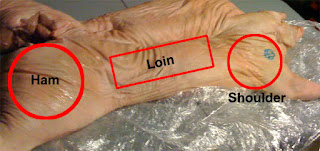Now the fun begins. Place your pig, on its back, on a large sturdy table. I did a little trimming and clean-up of the pig prior to adding any brine, or rub. The kidneys were still in place so I removed them. They ended up getting thrown away because I was not going to cook them. I also trimmed some of the loose fat to clean it up a little.
It may still be a little bloody, since it is fresh, so take some wet paper towel and wipe it clean.
Next, remove the silver skin, or membrane that is on the ribs. Although this step isn’t necessary, if left on it keeps seasonings and smoke from penetrating the meat. Simply place the back of your knife, or any other dull object, under the membrane, lift and loosen so you can grab it with your fingers, or a paper towel. Now pull the skin off the ribs. It should pull off in a large sheet. If it breaks just use your knife to restart.
Flip your pig over and look for any remaining hair. Although you will receive your pig sans hair there may be a few small spots that were missed. Simply use a disposable razor to remove any hair. In my case I used a propane torch to just burn off the few I found. The last thing you want is for a guest to find a hair in their pork.
Brine and Rub
Some people use marinades and a variety of spices when preparing their pig. I wanted to keep it as simple as possible, but make it taste great. I chose to inject a brine and use a dry rub.
A simple brine is nothing more than a sugar and salt solution in water. Try to find yourself an injector, or a veterinary syringe to inject your brine. Inject your solution in the hams, loins, and shoulders. This will help ensure your meat doesn’t dry out while cooking. I will explain the basics of brining and how it works in a later post.
Now start rubbing. I used my knife and cut the skin away from a portion of the meat to put the rub under the skin so that it would penetrate the meat. Make sure you apply a generous amount of rub all over, especially the underside where the meat is exposed and where you pulled away the silver skin from the ribs.
I added the recipe for the brine and dry rub I used on the Recipe page.
Put it on Ice
Now that you have prepared the pig you need to keep it cool until cooking time so it doesn’t start to spoil.
If you have a large cooler and ice this will work perfectly. However, if you are like me and did not have a cooler large enough to accommodate an 83 pound pig, you can use large heavy duty trash bags.
Use about 20 lbs of ice to ensure your swine stays cool overnight. I wrapped individual, 7 pound, bags of ice in a trash bag to ensure any melting ice would not leak onto the pig and wash any rub away. Place 2-3 bags of ice in the cavity of your pig and fold your pig back over the ice to keep it cool.
Place the pig into a heavy duty trash bag. Depending on the size of your pig this may require two bags. This is where a second person could become useful to help you lift your pig.
After placing it in a trash bag wrap it tight using either tape, or twine. If your pig came in a box from the butcher place it back in the box. This will help act as an insulator.
Keep your pig cool for at least 10-12 hours. Allow time for your brine to work, and break down the proteins in your meat before placing it on the grill.









